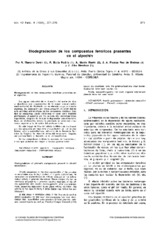Mostrar el registro sencillo del ítem
Bíodegradación de los compuestos fenólícos presentes en el alpechín
| dc.contributor.author | Maestro Durán, R. | |
| dc.contributor.author | Borja Padilla, R. | |
| dc.contributor.author | Martín, Antonio | |
| dc.contributor.author | Fiestas Ros de Ursinos, J.A. | |
| dc.contributor.author | Alba Mendoza, J. | |
| dc.date.accessioned | 2012-11-28T10:20:56Z | |
| dc.date.available | 2012-11-28T10:20:56Z | |
| dc.date.issued | 1991 | |
| dc.identifier.uri | http://hdl.handle.net/10396/8315 | |
| dc.description.abstract | Las aguas residuales de la obtención del aceite de oliva o alpechines son responsables de la mayor contaminación medioambiental de Andalucía por su elevada carga de materia orgánica. Su depuración por biometanización es difícil debido a la actividad antimicrobiana de los compuestos fenólícos. Este tipo de sustancias puede eliminarse en gran parte tratando previamente el alpechín por vía aerobia con microorganismos específicos, después de lo cual la depuración anaerobia tiene lugar sin inhibiciones, siendo la constante de velocidad cinco veces superior a la de antes del pretratamiento. En este trabajo se hace un estudio cualitativo de los fenoles por cromatografía en capa fina y cuantitativo de los fenoles totales, orto- y meta-difenoles, así como de la Demanda Química de Oxígeno del alpechín antes del tratamiento, después del pretratamiento y después de la biometanización. Se ha comprobado también la ausencia de leucoantocianinas que pudieran dar origen a fenoles polimerizados | es_ES |
| dc.description.abstract | Oil-mill wastewater is the main responsible of the pollution in Andalusian due to high content of organic substances. Its depuration by methanization is difficult because of the antimicrobial activity of phenolic derivatives. These compounds can be drastically reduced by a previous aerobic treatment of the oilmill wastewater with specific microorganisms. After this pretreatment, anaerobic depuration takes place without inhibition, the velocity of the reaction being 5 times higher than before the pretreatment. In this paper a qualitative study of the phenols present in oil-mill wastewater by thin layer chromatography has been done. Beside that, quantitative determination of total phenols, ortoand meta-diphenols as well as Chemical Oxigen Demand (COD) before the treatment, after the pretreatment and after biomethanization have been carried out. Finally, leucoanthocyanins that could originate polymerized phenols have not been found | es_ES |
| dc.format.mimetype | application/pdf | es_ES |
| dc.language.iso | spa | es_ES |
| dc.publisher | Consejo Superior de Investigaciones Científicas (CSIC) | es_ES |
| dc.rights | https://creativecommons.org/licenses/by-nc-nd/4.0/ | es_ES |
| dc.source | Grasas y Aceites 42 (4), 271-276 (1991) | es_ES |
| dc.subject | Alpechín | es_ES |
| dc.subject | Compuestos fenólicos | es_ES |
| dc.subject | Depuración anaerobia | es_ES |
| dc.subject | Pretratamiento aerobio | es_ES |
| dc.subject | Aerobic pretreatment | es_ES |
| dc.subject | Anaerobic depuration | es_ES |
| dc.subject | Oil-mill wastewater | es_ES |
| dc.subject | Phenolic compounds | es_ES |
| dc.title | Bíodegradación de los compuestos fenólícos presentes en el alpechín | es_ES |
| dc.title.alternative | Biodegradation of phenolic compounds present in oil-mill wastewater | es_ES |
| dc.type | info:eu-repo/semantics/article | es_ES |
| dc.rights.accessRights | info:eu-repo/semantics/openAccess | es_ES |

